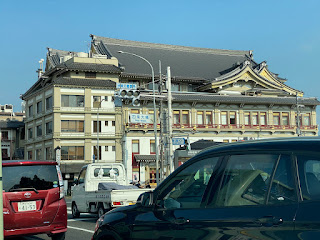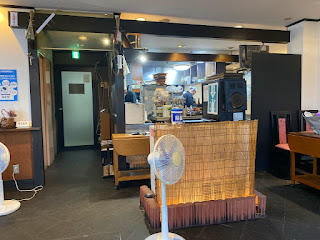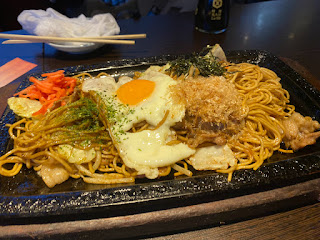I was excited to crush our first day of sweaty, sweaty Kyoto.
We did do a little morning reading before venturing out.
I remembered these covered shopping arcades being a thing back in the day, so I was sucked into one that I spotted near our hotel.
We spotted a Chinese place and popped in for lunch.
They had a dim sum lunch set thing that we went for.
We popped over to check out Nijo Castle but it didn't go well. It was so hot and I think they weren't going to let us use Ernie's stroller which was a deal breaker for us. Oh well.
Kyoto is known as the cultural heart of Japan, and you can definitely tell a big difference between the architecture of Tokyo and Kyoto. There's much more of a classic flair around here whereas Tokyo is often ultra-modern.
We met up with Peter MacIntosh for a Gion tour focusing on the world of the Geisha(in Kyoto parlance they are called Geiko). He had a wealth of information on the topic. He immediately taught me something interesting, which was that there are multiple Geisha districts and you can easily spot which hanamachi (花街, "flower towns") you are in by the symbols on the paper lanterns outside.
Peter had an interesting life story. I think maybe he was initially in Kyoto as a student but befriended a rich Japanese dude who introduced him to the world of geisha. He ended up breaking the rules, marrying one of them, and caused quite a kerfuffle in the process. Hearing life stories of foreigners who stayed in Japan always hit me hard because it easily could have been a series of choices that I could have made myself.
Take me down, to flower town. Gion is one of the most exclusive and well-known geisha districts in all of Japan.
I want to say that these tiny little shrines were to keep people from peeing on the buildings.
Tatsumi bridge
This was a geisha training school and different arts were listed for study such as ikebana. A geisha in training is referred to as a Maiko. My understanding is that Maiko are sort of indentured servants. They receive training, room, and board, and in return entertain guests for the house that has adopted them.
I'd like to spend a lot more time in this little world and more fully understand it. As a broke college student studying in Kyoto I was aware of the Geiko but I was too broke to hope to ever converse with one, so coming back and finally doing it was sort of a redemption arc for me.
We turned down a little alley and slid the wooden door to enter Harutomi Okiya.
"An okiya (置屋) is the lodging house/drinking establishment to which a maiko or geisha is affiliated with during her career as a geisha. The okiya is typically run by the "mother" (okā-san) of the house, who handles a geisha's engagements, the development of her skills, and funds her training through a particular teahouse. Though a geisha is legally required to be registered to an okiya in order to work, and may live there as a trainee, it is not a legal requirement for geisha to live within their okiya."
We got to meet a Maiko! Ernie was pretty interested in this new type of person as you can see.
Her name was Kotsuru and we got a little sticker trading card thing to keep. I believe how it works is the maiko trainee takes one character from her mentor's geisha name to construct her own. The three interlocking rings at the top signify that Kotsuru is part of the Miyagawa-chō crew. This symbol was on the lantern outside as well. According to Wikipedia the rings symbolize "the unity of the shrine/temples, the townspeople, and the teahouses."
Geisha have good snacks. There was iced green tea and some good mochi with fruit in it.
We got a good look at her impressive outfit from every angle. Seemingly every detail is full of meaning. "For most situations, a pattern known as eri-ashi (襟足, lit. 'nape legs') is worn, forming two triangular stripes of unpainted skin from the nape of the neck downward. For formal occasions, a three-stripe pattern known as sanbon-ashi (三本足, lit. 'triple legs') is used."
Ernie was jealous that everyone else was having snacks. Kotsuru's red eyeliner signified that she had advanced past the beginning stages of her training.
We played a little drinking game called Konpira Fune Fune. You keep a clapping pattern with your hands and take turns taking away the little bowl in order to screw the other person up. Whoever breaks the pattern loses and has to drink.
Introduction to the game
I was not great at it.
I think Lydia did better.
When the shamisen playing and dancing started, Ernie's head kept darting back and forth to try to watch both artists at the same time.
Afterward we had a nice stroll with Kotsuru on her way back to her house.
Here she is pointing to her name plate on her house's wall.
What a fun and unique time we had.
We asked our guide for a restaurant recommendation and he did a good job. Mamoriya izakaya may have been a bit "too" real for us though as people were smoking inside the restaurant. I can't believe this was ever a thing in the US.
We got some fried chicken karaage.
We got a healthy portion of yakisoba.
I don't think they get a lot of foreigners up here and I think they were amused by our presence. We must have sufficiently behaved ourselves because they gave us a business card and asked us to come back soon.
I have fond memories of sitting on the banks of Kyoto rivers and watching fireworks and doing other fun festival activities. I like this place.
I found Lydia a nice tea place called Saryo Tsujiri that was selling matcha ice cream.
They had a giant matcha whisk in the lobby.
Somebody is ready to go home.
I brought little tea flavored parfait from the tea shop. It was parfait.
































































































No comments:
Post a Comment